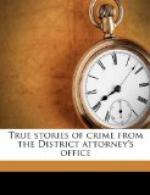This, in the most abbreviated form, is the case against Patrick. Space forbids any reference to his elaborate and ingenious defense, which was based entirely on an alleged complete failure of corroboration of Jones’s testimony. Starting with the premise that the word of a self-confessed murderer and thrice-perjured scoundrel was valueless as proof, he contended that there was no adequate evidence that Rice’s death was felonious, and that the congestion of the lungs could have been and was caused by the embalming fluid and was only attributed to the chloroform after Jones had given his final version of how the murder was accomplished. Technically the case against Patrick was not a strong one. Dramatically it was overwhelming. His own failure to testify and his refusal to allow his lawyer, Mr. House, to relate what passed between them in the Tombs, remain significant, although not evidence proper for a jury to consider. Wherever lawyers shall get together, there the Patrick case will be discussed with its strong points and its weak ones, its technicalities and its tactics, and the ethics of the liberation of Jones, the actual murderer, now long since vanished into the obscurity from which he came. On the one hand stands a public convinced of Patrick’s guilt, and on the other the convicted “lifer” pointing a lean finger at the valet Jones and stubbornly repeating, “I am innocent.”
[Footnote 4: In 1906 the Governor of New York commuted the death sentence of Albert T. Patrick to life imprisonment, and the most extraordinary struggle in the legal history of the State on the part of a convicted murderer for his own life came to an end. The defendant in the “Death House” at Sing Sing had invoked every expedient to escape punishment, and by the use of his knowledge had even saved a fellow prisoner, “Mike” Brush, from the electric chair.]
X
A Flight Into Texas
The flight and extradition of Charles F. Dodge unquestionably involved one of the most extraordinary battles with justice in the history of the criminal law. The funds at the disposal of those who were interested in procuring the prisoner’s escape were unlimited in extent and the arch conspirator for whose safety Dodge was spirited away was so influential in political and criminal circles that he was all but successful in defying the prosecutor of New York County, even supported as the latter was by the military and judicial arm of the United States Government. For, at the time that Dodge made his escape, a whisper from Hummel was enough to make the dry bones of many a powerful and ostensibly respectable official rattle and the tongue cleave to the roof of his mouth in terror.




